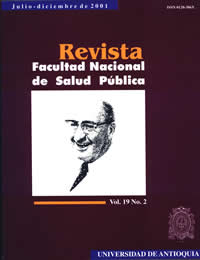Stages of change in cigarette consumers in Zarzal, Colombia, 1999
DOI:
https://doi.org/10.17533/udea.rfnsp.892Keywords:
Stages of change, transtheoretical model, smoking, health promotionAbstract
Downloads
References
(1). World Health Organization. Tobacco or health: a global status report. Geneva: WHO; 1997.
(2). World Health Organization. Guidelines for controlling/monitoring tobacco epidemic. Geneva: WHO; 1998.
(3). Cabrera G, Candeias N. El modelo de análisis estratégico para promoción de la salud y el control local del tabaquismo. Rev Fac Nacional de Salud Pública 1999;17(1):9-16.
(4). Nutbeam D, Harris E. Theory in a nutshell: a practitioner ́s guide to community theories and models in health promotion. Sydney: National Centre for Health Promotion; 1998.
(5). Glanz K, Lewis F, Rimer B. (eds). Health behavior and health education: theory, research and practice. 2 ed. San Francisco: Jossey Bass; 1997.
(6). Coombes Y, McPherson K. Review of health related models of behavior change: a report prepaed for the Department of Health in England. London: Health Promotion Unit of LSHTM; 1996.
(7). Cabrera G, Tascón J, Lucumí D. Creencias en salud: historia, constructos y aportes del modelo. Rev Fac Nacional de Salud Pública 2001;19(1):91-101.
(8). Cabrera G. Transteoría e análise estratégica no controle local do tabagismo em Zarzal, Colombia 1999. Sao Paulo; 1999. Tese de doutorado em saúde pública, CIR/Faculdade de Saúde Pública USP.
(9). Prochaska J, Velicer W. The transtheoretical model of health behavior change. Am J Health Promot 1997;12:38-48.
(10). O ́Donell M. The transtheoretical model of health behavior change. Am J Health Promot 1997;12:4. DOI: https://doi.org/10.4278/0890-1171-12.1.38
(11). Cabrera G. El modelo transteórico del comportamiento en salud. Rev Fac Nacional de Salud Pública 2000;18(2):129-138.
(12). Breslau N, Peterson E. Smoking cessation in young adults: age at initiation of cigarrette smoking. Am J Public Health 1996;86:2214-2220. DOI: https://doi.org/10.2105/AJPH.86.2.214
(13). Jackson C, Henriksen L, Dickinson D, Messer L, Robertson S. A longitudinal study predicting patterns of cigarette smoking. Health Educ Behav 1998;25:436-447. DOI: https://doi.org/10.1177/109019819802500403
(14). Stewin G. O adolescente e o fumo. Sao Paulo; 1977. Dissertaçao de mestrado CIR/Faculdade de Saúde Pública USP.
(15). Ivanovic D, Castro C, Ivanovic R. Factores que inciden en el hábito de fumar de escolares de educación básica y media de Chile. Rev Saúde Pública 1997;31:30-43. DOI: https://doi.org/10.1590/S0034-89101997000100006
(16). Organización Panamericana de la Salud. La aplicación de las teorías y las técnicas de las ciencias sociales a la promoción de la salud. Rev Panam Salud Pública 1998;4:142-148. DOI: https://doi.org/10.1590/S1020-49891998000800017
(17). Velicer W, Fava J, Prochaska J, Abrams D, Emmons K, Pierce J. Distribution of smokers by stage in three representative samples. Prev Medicine 1995;24:401-411. DOI: https://doi.org/10.1006/pmed.1995.1065
(18). Schorling JB. The stages of change of rural African American smokers. Am J Prev Medicine 1995; 11:170-177. DOI: https://doi.org/10.1016/S0749-3797(18)30469-0
(19). Etter J, Perneger T, Ronchi A. Distribution of smokers by stage: international comparison and association with smoking prevalence. Prev Medicine 1997;26:580-585. DOI: https://doi.org/10.1006/pmed.1997.0179
(20). Clark M, Kuiz F, Crittenden K, Warnecke R. Psychosocial factors and smoking cessation behaviors among smokers who have and have no ever tried to quit. Health Educ Res 1998;13:145-153. DOI: https://doi.org/10.1093/her/13.1.145
(21). Tessaro I, Lyna P, Rimer B, Heisler J. Readiness to change smoking behavior in a community health center population. J Community Health 1997;22:15-32. 10 DOI: https://doi.org/10.1023/A:1025142706754
Downloads
Published
How to Cite
Issue
Section
License
The contents of the articles are the responsibility of the authors
The editorial committee has editorial independence from the National School of Public Health "Héctor Abad Gómez" of the University of Antioquia.
The editorial committee is not responsible for aspects related to copying, plagiarism or fraud that may appear in the articles published in it.
When you are going to reproduce and disclose photographs or personal data in printed or digital format, informed consent is required. Therefore, this requirement is required of the author at the time of receipt of the manuscript.
Authors are responsible for obtaining the necessary permissions to reproduce any material protected by reproduction rights.
The authors preserve the moral rights and assign the economic rights that will correspond to the University of Antioquia, to publish it, distribute electronic copies, include them in indexing services, directories or national and international databases in Open Access, under the Creative Commons Attribution license -Not Commercial-Share Equal 4.0 International Commercial (CC BY-NC-SA) which allows others to distribute, remix, retouch, and create from the work in a non-commercial way, as long as the respective credit and license are granted. new creations under the same conditions.
The authors will sign the declaration of transfer of economic rights to the University of Antioquia, after the acceptance of the manuscript.
The editorial committee reserves the right to reject the articles whose authors do not offer satisfactory explanations about the contribution of each author, to meet the criteria of authorship in the submission letter. All authors must meet the four criteria of authorship according to ICMJE: "a) .- That there is a substantial contribution to the conception or design of the article or to the acquisition, analysis or interpretation of the data. b) That they have participated in the design of the research work or in the critical review of its intellectual content. c) .- That has been intervened in the approval of the final version that will be published.d). That they have the capacity to respond to all aspects of the article in order to ensure that issues related to the accuracy or integrity of any part of the work are adequately investigated and resolved. "












 --
--  --
--
